Harman Stove Company TLC 2000 User Manual
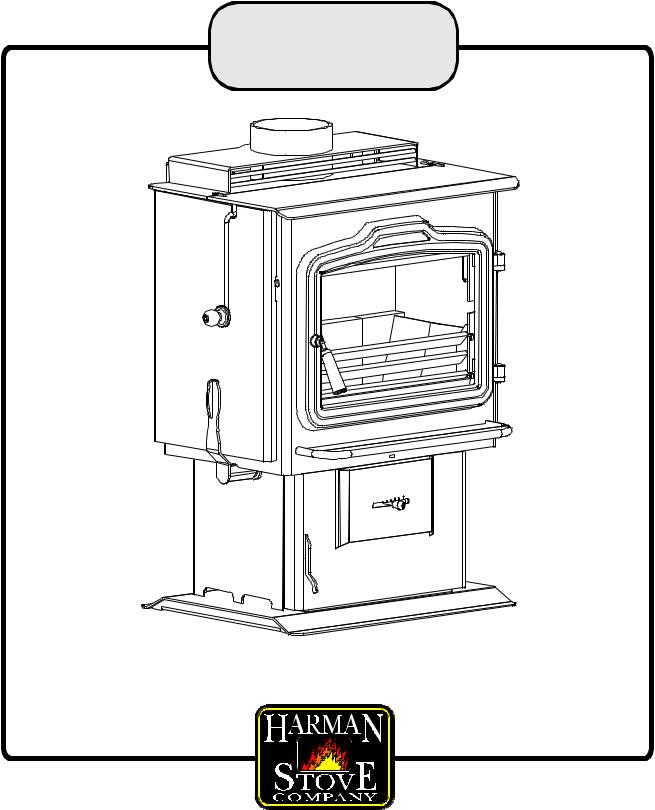
HARMAN
TLC 2000
OPERATOR'S
MANUAL
FOR USE IN THE U.S. AND CANADA
SAFETY NOTICE: IF THIS HARMAN TLC 2000 STOVE IS NOT PROPERLY INSTALLED, A HOUSEFIRE MAY RESULT. FOR YOUR SAFETY, FOLLOW INSTALLATION DIRECTIONS.
CONTACT LOCAL BUILDING OR FIRE OFFICIALS ABOUTRESTRICTIONSAND INSTALLA-
TION INSPECTION REQUIREMENTS IN YOUR AREA.
R6

TLC 2000 Coal Stove |
2 |
INDEX |
|
Specifications |
4 |
Operation |
6 |
Building a Fire |
7 |
Maintenance |
11 |
Installation |
13 |
Chimney System |
15 |
Parts List |
19 |
Parts Diagram |
20 |
Warranty |
21 |
|
|
Please read this entire manual before you install and use your new room heater. Failure to follow instructions may result in property damage, bodily injury, or even death.
NOT TESTED FOR MOBILE HOME INSTALLATIONS.
SAVE THESE INSTRUCTIONS
Harman Stove Company
352 Mountain House Road
Halifax,PA 17032
U.S.A.

TLC 2000 Coal Stove |
3 |
WARNINGS
Carbon Monoxide (CO) Awareness
Carbon monoxide referred to as CO, is a colorless, odorless gas that is produced during combustion of coal and other fuels. CO fumes are toxic and can be fatal.
The TLC 2000 is a closed loop system specially designed to prevent the escape of CO and other combustion products from the stove.
Even though this stove is designed to be as safe as possible, it is important that you install a CO detector. This is true for oil, gas, or wood as well.
CO is heavier than air. This causes accumulation to occur at the floor first. Therefore, it is best to install the detector at table top level or lower rather than on the ceiling like a smoke detector.
CO detectors are very sensitive and may sound
an alarm for fumes other than CO or CO from sources other than the stove such as car or lawn mower exhaust.
If the alarm sounds
1.Increase ventilation by opening windows or doors.
2.Make sure the stove doors and hopper lid are closed and latched.
3.Check stove for electrical power and normal operation.
4.Check for false alarm.
(Never sleep in the same room with any coal burning stove.)
Never use gasoline, gasoline-type lantern fuel, kerosene, charcoal lighter fluid, or similar liquids to start or “freshen up” a fire in this heater. Keep allsuch liquids wellaway from the heater while it is in use.
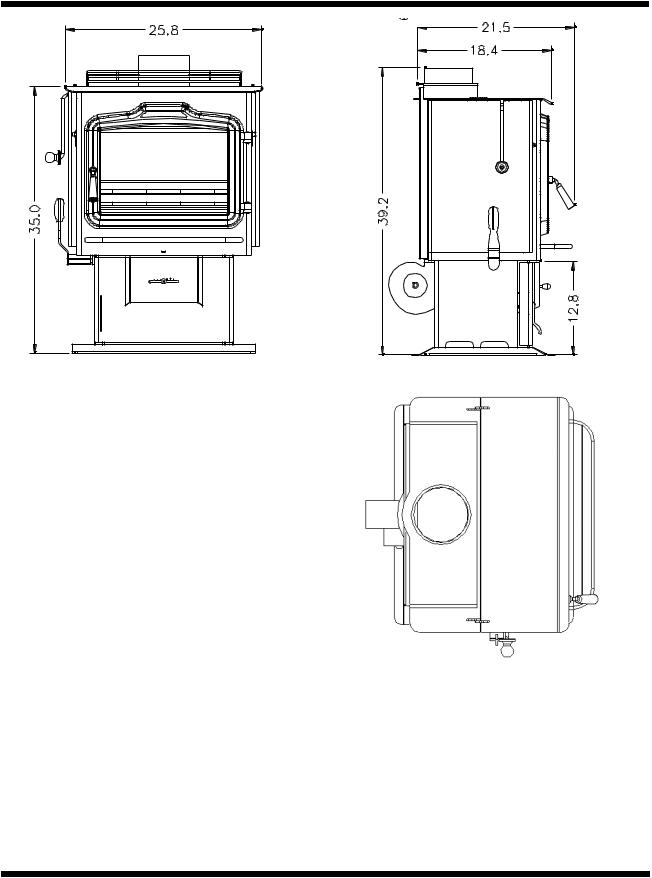
TLC 2000 Coal Stove |
4 |
Specifications - Harman TLC 2000
Weight |
375 lbs |
Flue Size |
6 inch |
Log Length Recommended |
16" with 18" Max |
Heating Capacity |
1,900 sq. ft. |
Blower Size (optional) |
135 variable speed |
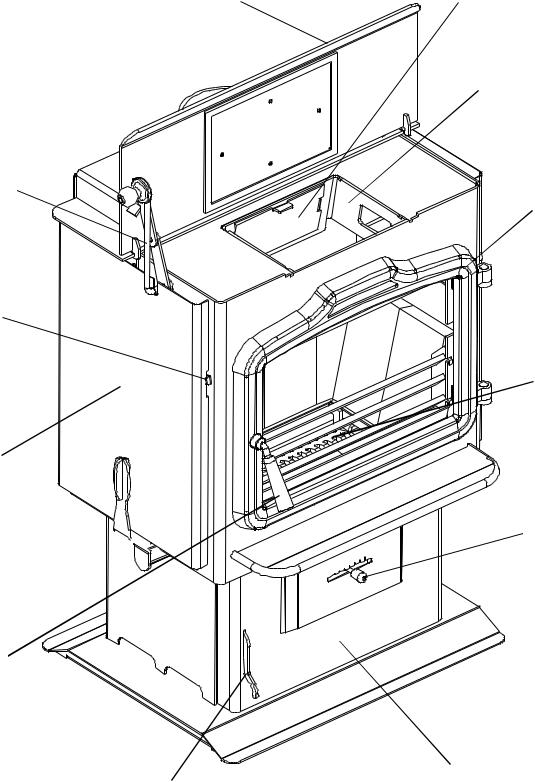
Top Load Door
Top Load
Door Arm
Wood Air
Control
Side Shield
Removable 


Shaker Handle
Front Load
Door Latch
TLC 2000 Coal Stove |
5 |
Clean-out Cover
Top Load Opening
Glass Door
Grates
Coal Air Control
Ash Door
Ash Door Latch
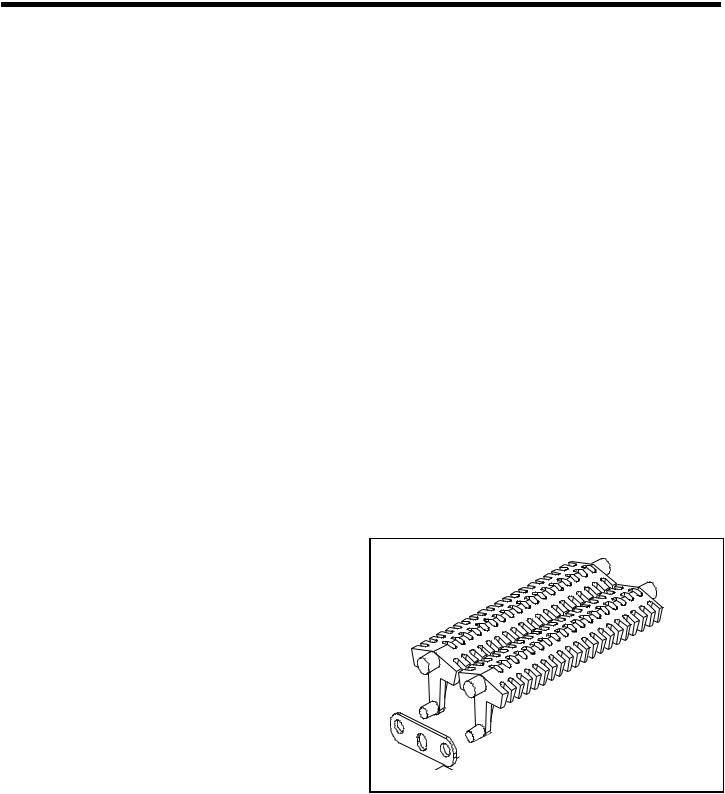
TLC 2000 Coal Stove |
6 |
Operation
The Stove
Doors
Your stove has a large glass-paneled door for loading and fire viewing, a separate smaller door for removing ashes and a top loading door. To open the glass door, turn the handles clockwise and pull out; to close the door, return the handles to an open 9 o'clock closed 6 o'clock, and push in to engage the latch while turning the handles counterclockwise. To open the ash door, lift up the handle and pull out. Close the door by pushing in and pushing the handle all the way down. To open the top load door move the wooden knob located on the left side of the stove front and upward until it locks the top open. Page 6.
If the latch in either of your TLC 2000 doors needs adjustment, follow the instructions given in the Maintenance section.
All doors must be closed while the stove is in normal operation, and the gaskets routinely examined for wear and replaced when necessary. The glass door may be left open and the opening covered with a screen when operating as a fireplace. Good door seals are important for maintaining control of the stove. Operating the stove with the ash door open, or with a door inadequately sealed, could create a serious overfiringcondition (discussed later in this section).
NEVER OPERATE WITH MORE THAN ONE DOOR OPEN AT A TIME
The glass used in your TLC 2000 is manufactured to exact standards to withstand the high heat of the fire, but like all glass, it must be treated with common sense and care. Never abuse the glass by slamming the door shut or striking the glass with a heavy object. If the glass is broken or damaged, do not operate the stove until it has been replaced (See instructions in the Maintenance section.)
Grates
The Harman TLC 2000’s unique grate system consists of two Cast iron grates linked together to operate simaltainiously when the external shaker handle is moved.
The purpose of the grate system is to to support the coal bed while air flows up through the grates to the burning coal. The grates are also used to remove ashes from the bottom of the coal bed while the fire is burning. This is accomplished by shaking the shaker lever back and forth with short choppystrokes. This causes the ashes to fall through the grates into the ash pan. It is the special design of the Harman Grates that allows longer intervals between refueling and shaking the grates.
Fuels for USA
Wood:
Wood may be burned in the TLC2000for the purpose of igniting coal.
Wood may also be burned with the glass door open and a screen in place to prevent sparks from escaping. This provides a real open fire atmosphere.
Coal:
Anthracite coal, pea or nut size, is the primary fuel for which the TLC2000 is designed. Bituminous coal may also be burned but the results will varydo to the variation in bituminus coal from state to state.
Fuels for Canada
Wood:
Wood may be burned as a primary fuel. This is because U.S. EPA regulations do not apply in Canada.
Wood may also be burned with the glass door open and a screen in place to prevent sparks from escaping.
Coal:
Anthracite coal, pea or nut size, may also be burned as a primary fuel for the TLC2000. Bituminous coal may also be burned but the results will varydo to the variation in bituminus coalfrom province to province.
Harman Grate System
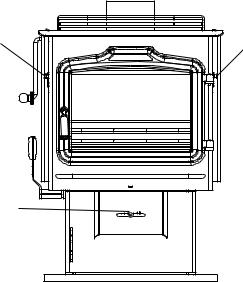
TLC 2000 Coal Stove |
7 |
Air Controls
|
|
Coal |
|
|
The primary air control for coal burning is a knob |
|
|
located on the bottom door. Sliding the knob to the left pro- |
|
|
vides less air for a smaller fire. Sliding the knob to the right |
|
|
provides more air for a larger fire.When burning wood this |
|
|
knob should be all the way to the left, closed. |
|
|
Wood |
|
|
The primary air controls for wood burning are lo- |
WOOD |
WOOD |
cated on each side as shown below and on page 4. Both con- |
|
trols should be adjusted equally. Air from these controls also |
|
|
|
|
|
|
provides a curtain of air across the glass to keep it clean. |
|
|
Move the controls down for less heat and up for more heat. |
|
|
When burning coal these controls should be in the down posi- |
|
|
tion. CAUTION: The wood controls are hot. Use the |
|
|
removable shaker handle or gloves to adjust these con- |
|
|
trols. |
|
|
Coal must have air coming up through the coal bed in |
|
|
order to burn. Some air over the top of the coal helps burn |
COAL |
|
gases. A small amount of air enters the top of the coal fire |
|
|
when the wood controls are in the down position. |
|
|
Wood burns with top or bottom air; however, top air |
|
|
coming down across the glass to form an air curtain works |
|
|
best and keeps the glass clean. |
|
|
This is why it is recommended that the coal control be |
|
|
positioned to the left for wood burning. |
Building and
Maintaining a Wood Fire
Never use gasoline, gasoline-type lantern fuel,
kerosene, charcoallighter fluid, or similar liquids to start or “freshen up” a fire in this heater. Keep all such
liquids well away from the heater while it is in use
.
Crumple up six to eight sheets of news paper and place in the firebox. Next place pieces of dry wood 3/4 inch maximum diameter on top of the paper, Next place several 1 " - 2" split pieces of dry wood on top, followed by a few 2" - 3" split pieces. Set the wood air controls at the maximum heat output setting, all the way up. Place the knob on the bottom door to the left. These settings will allow the glass to stay clean as you build your fire. The coal knob may be moved to the right to speed the ignition process but the glass may get dirty.
Ignite the paper and allow the fire to burn until a good charcoal bed, 2" - 3" (50 mm - 80 mm) is formed; (You may need to leave the ash door open a crack to get the blaze going properly, but never leave the stove unattended.) Add more wood to create a deeper charcoal base 3" to 4".
Once the charcoal bed is established you may add a full
